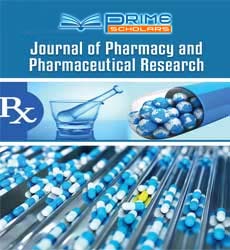Short Communication - (2022) Volume 6, Issue 3
The Most Important Role of Pharmacogenomics
Elena Patro*
Department of Pharmacy, University of Perth, Australia
*Correspondence:
Elena Patro, Department of Pharmacy, University of Perth,
Australia,
Email:
Received: 01-Jun-2022, Manuscript No. IPIPR-22-13910;
Editor assigned: 03-Jun-2022, Pre QC No. IPIPR-22-13910 (QC);
Reviewed: 17-Jun-2022, QC No. IPIPR-22-13910;
Revised: 22-Jun-2022, Manuscript No. IPIPR-22-13910 (R);
Published:
30-Jun-2022, DOI: 10.21767/ipipr.6.3.11
Introduction
Pharmacogenomics is the study of the role of the genome in drug
action. Its name (reflects the connection between pharmacology
and genomics. Pharmacogenomics studies what the hereditary
cosmetics of a singularity mean for its response to drugs. It manages
the effects of acquired and acquired hereditary minor variations
in drug response in patients through appropriate articulation
or single nucleotide polymorphisms with pharmacokinetics drug
retention, transport, digestion, and cessation) and pharmacodynamics
effects mediated by a drug’s natural targets. Although the
two terms are related to drug responses in terms of hereditary
effects, pharmacogenetics focuses on quality collaborations in single
drugs, while pharmacogenomics encompasses a broader affiliation
approach that consolidates genomics and epigenetics while
managing the impact of different qualities on drug response.
Description
Pharmacogenomics expects to promote normal means of rationalizing
drug treatment in relation to patient genotype to ensure the
greatest possible productivity with negligible adverse effects. By
using pharmacogenomics, there is confidence that medicines can
disperse based on the so-called “one-serving-for-all” approach.
Pharmacogenomics is also striving to forgo the experimental strategy
of recommendation to allow physicians to think about their
patient’s properties, the usefulness of those properties, and what
this might mean for the viability of the patient’s current or future
drugs admit. To the disappointment of previous drugs. Such methods
guarantee the appearance of accurate medicines and surprisingly
tailor-made medicines, where medicines and drug mixtures
are improved for thin subgroups of patients or in any case for each
individual’s unique hereditary cosmetics. Whether it is used to understand
a patient’s response or the scarcity in that department
to a treatment, or serves as a predictive device, it aims to achieve
better patient outcomes, more remarkable viability, minimizing
the occurrence of drug poisoning and unfriendly drug reactions
(ADR’s) [1,2]. For patients who do not show a helpful response to treatment, elective treatments that best meet their needs may
be recommended. To make pharmacogenomics suggestions for
a specific drug, two possible types of information can be used:
genotyping or exome or whole genome sequencing. Sequencing
provides much more interesting data, including the discovery of
transformations that prematurely terminate the orchestrated protein.
Pharmacogenomics was first developed around 510 BC. By
Pythagoras when he linked the risks of ingesting broad beans with
hemolytic pallor and oxidative stress. This distinctive evidence
was later approved and attributed to the absence of G6PD in the
1950’s and termed favism. Although the primary distribution of
authority dates back to 1961, the 1950’s or so marked the informal
beginnings of this science. Reports of protracted loss of motion
and fatal reactions associated with hereditary variations in patients
requiring butyrylcholinesterase after the organization of an
infusion of succinylcholine during sedation were first announced
in 1956 [3,4].
Conclusion
Patient genotypes are typically classified into the concomitant
expected aggregates: UM: Ultrafast Metabolizer: Patients with
greatly expanded metabolic capacity; EM: Extensive Metabolizer:
usual metabolic effect; M: intermediate metabolizers: patients
with reduced metabolic performance; and PM: Poor Metabolizer:
Patients with almost zero beneficial metabolic activity. The
two frontiers of this area are the unlucky metabolizers and the
super-rapid metabolizers. The effectiveness of a drug depends
not only on the metabolic situations mentioned above, but also
on the type of medication taken. Drugs can be ordered into two
main groups: dynamic drugs and prod rugs. Dynamic drugs allude
to drugs being inactivated during digestion, and prod rugs are idle
until processed.
Acknowledgement
The author is grateful to the journal editor and the anonymous
reviewers for their helpful comments and suggestions.
Conflict of Interest
The author declared no potential conflicts of interest for the research,
authorship, and/or publication of this article.
REFERENCES
- Becquemont L (2009) Pharmacogenomics of adverse drug reactions: Practical applications and perspectives. Pharmacogenomics. 10(6):961–9.
[Crossref] [Google Scholar] [PubMed]
- Sheffield LJ, Phillimore HE (2009) Clinical use of pharmacogenomics tests in 2009. Clin Biochem Rev. 30 (2):55–65.
[Google Scholar] [PubMed]
- Prasad K (2009) Role of regulatory agencies in translating pharmacogenetics to the clinics. Clin Cases Miner Bone Metab. 6(1):29–34.
[Google Scholar] [PubMed]
- Dean B, Barber N, Schachter M (2000) What is a prescribing error?. Qual Health Care. 9(4):232–7.
[Crossref] [Google scholar] [PubMed]
Citation: Elena P (2022) The Most important Role of Pharmacogenomics. J Pharm Pharm Res Vol.6 No.3:11
Copyright: © Elena P. This is an open-access article distributed under the terms of the Creative Commons Attribution License,
which permits unrestricted use, distribution, and reproduction in any medium, provided the original author and source are
credited

